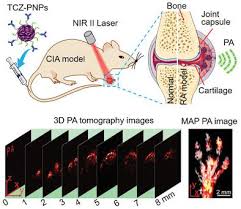Recently, the team of Liu Chengbo, the associate researcher of the Biomedical Optics and Molecular Imaging Laboratory of the Institute of Medical Engineering, and the team of Zhang Peng, a researcher of the Center for Translational Medicine, and the team of Professor Ding Dan of Nankai University have collaborated in the light acoustic molecular imaging research and a breakthrough has been made in this area. The research is based on near-infrared two-zone three-dimensional photoacoustic molecular imaging technology, combined with tocilizumab-conjugated polymer nano-diagnostic preparations with high specificity for rheumatoid arthritis, and successfully achieved the early assessment and diagnosis of inflammation in the mouse rheumatoid arthritis model, and accurate monitoring of the treatment effect of rheumatoid arthritis. Related research work was published in Advanced Materials with the title Tocilizumab-Conjugated Polymer Nanoparticles for NIR-II Photoacoustic Imaging-Guided Therapy of Rheumatoid Arthritis.

Rheumatoid arthritis (RA) is a multiple immune osteoarthritis disease. The onset is hidden and the cause is unknown. Early redness, swelling, heat, and pain appear. As the disease progresses, bone erosions in bones and joints eventually lead to disability. Early diagnosis and treatment of RA are critical to the prognosis. Compared with tumor lesions, RA lesions have a higher blood background and inflammatory factors are distributed in cartilage and joint capsules, which pose a higher challenge to photoacoustic molecular imaging. Near-infrared two-zone photoacoustic molecular imaging realizes highly sensitive and specific imaging under large penetration depth, providing a new strategy for imaging-guided RA diagnosis and treatment.
The photoacoustic molecular imaging technology independently developed by the research team, based on the RA-targeted therapeutic antibody tocilizumab (TCZ) modified conjugated polymer nanoformulations (TCZ-PNPs), achieves challenging high-quality imaging at the in vivo level. The results of the study show that TCZ-PNPs have excellent optical properties and biocompatibility, as well as good RA joint lesion targeting ability. Under the guidance of three-dimensional photoacoustic molecular imaging, it can accurately perform non-invasive detection of RA joint tissues at an early stage, the image signal-to-noise ratio is as high as 35.8 dB. Using TCZ-PNPs for one month of treatment, PA monitoring results showed that RA joint symptoms can be effectively suppressed. The results of photoacoustic diagnosis and treatment are consistent with the results of Micro-CT imaging and histological analysis. This study proves that the near-infrared two-zone photoacoustic molecular imaging technology can perform highly sensitive and specific imaging of RA lesions, providing a new strategy for RA diagnosis and treatment and RA treatment monitoring.